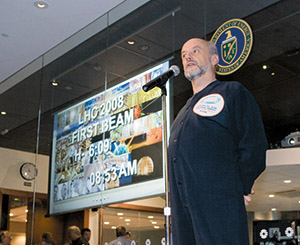Pajama party
By Benjamin Recchie, ABí03
Image courtesy Fermilab
A throng of physicists, students, journalists, and science fans—many clad in robes, slippers, and blanket sleepers—converged on Fermi National Accelerator Laboratory around 1:30 a.m. September 10. Although the party called for pajamas, the purpose was more lab coat: they were there to witness from afar the debut experiment of the Large Hadron Collider (LHC). Located along the Franco-Swiss border, the LHC is a particle accelerator seven times more powerful than Fermilab’s Tevatron collider.
Herman White, physicist and emcee for the night, welcomed the roughly 400 visitors to the home of the Tevatron, which he noted would continue to hold the title of the world’s most powerful particle accelerator “until three-and-a-half hours from now.” Behind him a large screen showed a live video feed from the European Organization for Nuclear Research, or CERN, the high-energy physics lab that houses the LHC. People working at their desks, a crowd milling about, occasional illustrations of the beam’s progress—all accompanied by breathless narration from a woman with a British accent.
 Fermilab director Pier Oddone dresses for the occasion in sleeper pajamas.
Fermilab director Pier Oddone dresses for the occasion in sleeper pajamas. White’s comments highlighted a real, albeit friendly, rivalry between Fermilab and CERN, which serve as twin centers of the particle-physics universe. Each lab is eager to lay claim to discoveries that provide fundamental information about the universe, such as proving the existence of the Higgs boson, a theoretical subparticle thought to give otherwise massless elementary particles mass. Despite the competition, they regularly collaborate. For instance, Fermilab built nine magnets for the LHC that guide and focus the proton beams’ movements to maximize collisions. The Batavia, Illinois–based facility has also installed a glass-walled, remote-operations center where North American physicists can monitor the LHC without having to fly to Switzerland.
As CERN researchers put the new machine through its paces—making sure they could accelerate protons from low to high speeds, inject them into the collider’s main ring, and get that beam of protons to circumnavigate the ring—scientists inside Fermilab’s remote-operations center monitored the computer systems linking the labs. Meanwhile the live feed—including a black-and-white diagram showing the beam’s progress around the ring—kept the sleep-deprived crowd updated. At 3:27 a.m. the experiments culminated with a beam barreling around the LHC’s 16.6-mile circumference. The test amounted to a relative baby step, with a beam just energetic enough to verify that all the components worked. By spring 2009 scientists aim for the machine to create nearly 600 million proton-proton collisions per second.
After an early breakfast the crowd milled about. Some watched a live teleconference with the scientists who ran the tests, some peered into the remote-operations center, and some examined preliminary data from the experiments on their laptops. As the hour neared 5 a.m., the room began to empty as visitors ventured out of Wilson Hall into the prairie dawn.
At the time, the LHC operated even better than expected, as the video backdrop to breakfast had made plain: “I never would’ve expected such a smooth go-round of the beam,” said Rolf-Dieter Heuer, the particle and astroparticle physics research director at the German laboratory DESY, who becomes director-general of CERN in January.
But the thrill wouldn’t last. Nine days later CERN researchers found what appeared to be a faulty electrical connection between two of the machine’s magnets. The result was a six-ton leak of liquid helium, used to cool the magnets to nearly absolute zero. Without the helium, the temperatures of 100 of the LHC’s 1,232 magnets rose 100 degrees Celsius. Repairing the problem will keep scientists from running experiments until April, allowing the Tevatron to hold its mantle as the world’s highest-energy collider several months longer than expected.
